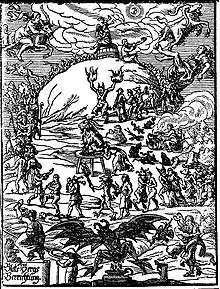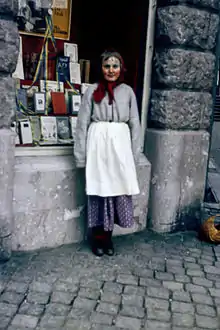Blockula
Blockula (Blåkulla in modern Swedish) was a legendary island where the Devil held his Earthly court during a witches' Sabbath. This island could only be reached by a magical flight. It was described as "a delicate large Meadow, whereof you can see no end".


There was said to be a large gate located in the meadow that led to a smaller meadow. In the smaller meadow there stood a house. In an enormous room in this house: "[…] there stood a very long Table, at which the Witches did sit down: And […] hard by this Room was another Chamber, where there were very lovely and delicate Beds."
The Devil was dressed "in a gray Coat, and red and blue Stockings: He had a red Beard, a high-crown’d Hat, with Linnen of divers Colours, wrapt about it, and long Garters upon his Stockings". The Devil then "would go with them that he liked best, into a Chamber, where he committed venerous Acts with them: and this indeed all confessed, That he had carnal knowledge of them, and that the Devil had Sons and Daughters by them, which he did Marry together, and they did couple, and brought forth Toads and Serpents."
Blockula plays a major part in the witch-hunts described in Joseph Glanvill's 1682 work, Sadducismus Triumphatus. This book detailed Blockula in an Appendix entitled: "True Account of What Happen’d in the Kingdom of Sweden In the Years 1669, 1670, and upwards: In Relation to some Persons that were accused for Witches; and Tryed and Executed By the King’s Command".
Blockula is originally the same place as the island Blå Jungfrun, which was in old days called Blåkulla, and since medieval days rumored to be a place were the witches gathered. The perhaps first time Blockula was mentioned in a witch trial by an alleged witch was in 1597, but in reality, it was not until the witch mania of 1668-1676 that the place had any real importance in the persecution of witches.
Modern traditions

In Sweden and Swedish-speaking parts of Finland, to commemorate the travel of witches to Blåkulla, children dress as witches, old women and old men on Easter and go door-to-door for treats similar to the trick-or-treating tradition of halloween. The children sometimes present hand-made cards and other greetings.[1]
See also
References
- "Svenskspråkiga påskhäxor går ut på påskaftonen". Yle. March 13, 2010.
- Giornale Nuovo "A True Account of What Happen’d in the Kingdom of Sweden" (August 22, 2005)
- All quotes from Glanvill, Joseph "Saducismus Triumphatus" (1682)
- Alf Henrikson, "Häxorna", (In Swedish).
- Häxor i periferin:Trolldomsprocesser i Småland 1604-1619(In Swedish)
- Birgitta Lagerlöf-Genetay, De svenska häxprocesernas utbrottskede 1668-1676.
